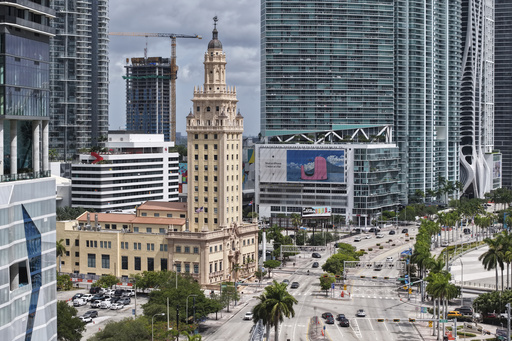
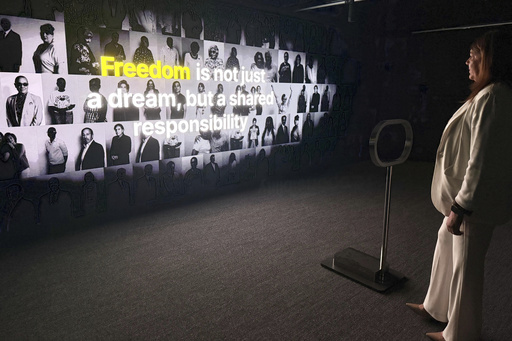
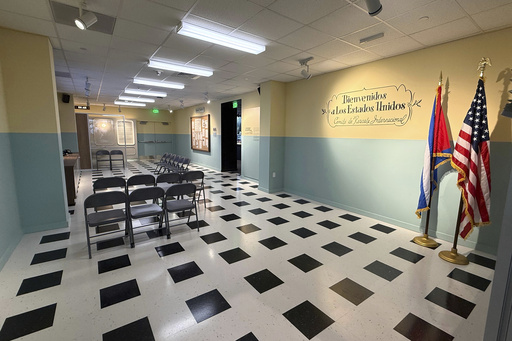
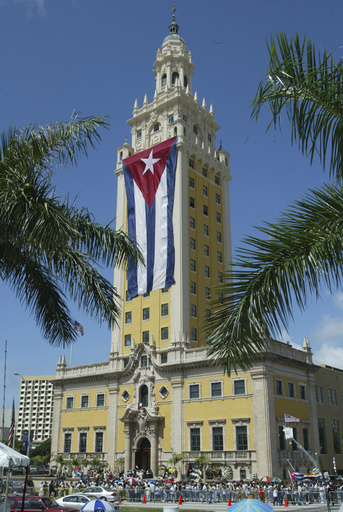
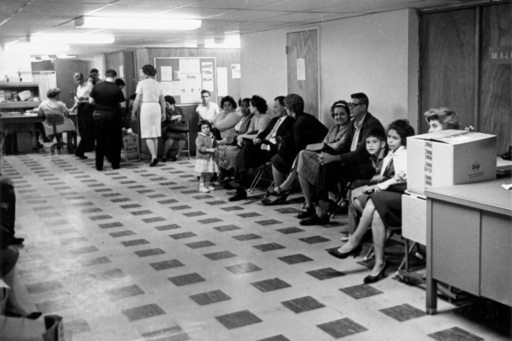
MIAMI (AP) — For decades, its powerful lighthouse illuminated Miami’s Biscayne Bay, and during the height of the Cold War, what was known as the Freedom Tower stood as a beacon of hope for hundreds of thousands of Cubans fleeing communist rule.
The 14-story Spanish Revival skyscraper was where, from 1962 to 1974, the U.S. State Department welcomed Cuban refugees with medical services, English classes, and comfort kits containing essentials and something wholly exotic to the new arrivals: peanut butter.
After decades of neglect, what was once Miami’s tallest building is getting a well-deserved facelift. Next month, it will reopen as a museum honoring the history of Cuban exiles with immersive, state-of-the-art exhibits that explore the meaning of migration, freedom and homeland.
The reopening of what’s dubbed the Ellis Island of the South comes at a sensitive moment. Cuban Americans — who dominate politics in Miami — voted overwhelmingly for Donald Trump in the last presidential election. But the president’s crackdown on migrants — including Cubans — is increasingly viewed as a betrayal and has left many second-guessing that support. Not surprisingly, recent protests against Trump have gathered outside the tower.
The organizers of the museum, while tiptoeing around the present-day politics, are nonetheless unapologetic in their embrace of the American dream. In Miami, a thriving crossroads where 70% of residents speak Spanish as their first language and more than half are foreign-born, compassion for migrants runs deep.
“It’s cyclical,” said Rene Ramos, the head archivist at Miami Dade College, which spearheaded the $65 million renovation. “This country has had moments where it clearly saw the value of immigrants and other moments when it did not. What we’re doing here is reminding people what immigrants can accomplish when they’re given the opportunity.”
The iconic building opened in 1925 as the headquarters of the once-acclaimed Miami Daily News, which shuttered decades ago. It was designed, in the style of a Moorish bell tower from Seville, Spain, by the New York architectural firm Schultze & Weaver, which was behind some of the most glamorous hotels, theaters and office towers of the era.
It was renamed the Freedom Tower when President John F. Kennedy launched the Cuban Refugee Assistance Program to resettle the streams of middle-class individuals and families fleeing Fidel Castro’s revolution. It’s estimated that nearly 400,000 Cubans relied on services provided at the tower by the U.S. government in coordination with the then-fledgling Roman Catholic Archdiocese of Miami. The total cost of the refugee assistance ran over $730 million by 1971 — almost $6 billion in today's dollars — a U.S. government report from that year found.
Known to the Spanish-speaking migrants as “El Refugio,” or “The Refuge,” it was a safe place to get vaccines, fill out paperwork, and receive financial assistance of around $120 per month. In the Grand Hall, with its giant windows and Corinthian columns, the Pizarra de la Suerte — the Bulletin Board of Good Luck — carried job notices to help the Cubans adjust to their new life, according to a replica of the hall in the museum.
At the time, metropolitan Miami was a tropical tourist town, with fewer than 1 million inhabitants. Most émigrés fanned out across the United States.
“They weren’t staying in Miami because they didn’t want warmth and sunshine. There were no jobs,” said Madeline Pumariega, the president of Miami Dade College, whose own Cuban parents hightailed it to Amarillo, Texas, after arriving here.
But over time, the exiles would trudge back from the cold and snow to put their unmistakable Cuban stamp on what over the ensuing decades would become one of America’s most vibrant cultural and economic hubs.
Jorge Malagón, who teaches history at Miami Dade College, was just 5 when he arrived. But he still wells up recalling the hardship of his departure — when Cuban customs officials ripped open his teddy bear looking for contraband jewelry — and arriving in Miami on a “Freedom Flight” paid for by the U.S. government and being immediately shuttled in a school bus from the tarmac to the Freedom Tower.
“The memories never go away,” said Malagón, who recalls being welcomed with a bar of unfamiliar peanut butter and a block of government cheese. “To this day, a grilled cheese sandwich with cheap, Velveeta processed cheese is still comfort food to me.”
The Freedom Tower, a national historic landmark, was long ago overtaken by Miami’s fast-growing steel and glass skyline. Abandoned for years, it was rescued in 1997 by Cuban American businessman Jorge Mas Canosa, a top exile opponent of Castro. He later sold it to a prominent Cuban American family and it was then donated to Miami Dade College.
Even in a dilapidated state, the tower remained a mecca of the Cuban diaspora. In 2003, tens of thousands of salsa fans gathered here to show their respects to Cuban-born singer Celia Cruz. And Secretary of State Marco Rubio, whose parents migrated from Cuba, used it as the backdrop to announce his bid for the U.S. presidency in 2015.
The current restoration was funded by $25 million investment from the state of Florida, with additional funding from MDC, private donors and federal government grants.
Galleries designed by the same firm behind New York City’s National September 11 Memorial & Museum provide a gripping account of the Cuban American journey to freedom. They include exhibits dedicated to Victims of Communism, the 1961 Bay of Pigs invasion that the CIA organized against Castro, and the 14,000 unaccompanied minors sent by their parents as part of the U.S.-led Operation Peter Pan.
Giant media screens project scenes of protest and acts of courage by newer residents of the Magic City fleeing persecution in Venezuela, Haiti and Nicaragua. There’s also a makeshift recording studio for those who passed through the Freedom Tower to add their testimony to an archive of over 300 oral history interviews with exiles, including prominent voices like singer Gloria Estefan.
Emerging from the dark galleries of often traumatic stories of dislocation and exile, the museum’s final stop is a gallery flooded with all the sun, salsa and pastel hues that make modern-day Miami so beloved.
“Miami and the world would not be what it is today without them,” said Pumariega. “That’s important and so is the contributions that immigrants play in our country, and I think will continue to play beyond this moment.”

 Associated Press US News
Associated Press US News
 Raw Story
Raw Story AlterNet
AlterNet Associated Press Top News
Associated Press Top News The Daily Mining Gazette Sports
The Daily Mining Gazette Sports Fortune
Fortune The Daily Mining Gazette
The Daily Mining Gazette